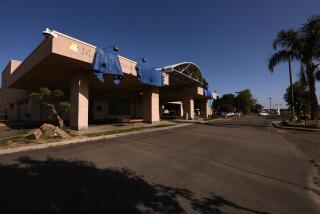2 Hospitals Agree to Cost-Cutting Merger : Health care: Inter-Community and Queen of the Valley hope to complete the consolidation by mid-1992.
The executive boards of two east San Gabriel Valley hospitals have approved a plan to merge.
Duane Carlberg, chief executive officer of Inter-Community Health Services, which operates Inter-Community Medical Center in Covina, and Jim Haden, chief executive officer of Queen of the Valley Hospital and Health Services in West Covina, said they signed the agreement worked out by their boards on Oct. 22.
The plan, which would create a new corporation, must be approved by the state attorney generalâs office and the Federal Trade Commission.
In the meantime, both Inter-Community, a 69-year-old, 280-bed facility, and the 268-bed Queen of the Valley, which has been open since 1962, will operate as usual. Each will offer a full line of services until the transition is completed in mid-1992, officials said this week.
The merger is designed to save money by eliminating duplication of specialized treatment--such as neonatal and coronary care--by providing them at only one facility, officials said. The consolidation of such services will require just one set of equipment, operated by one staff, Carlberg said.
Plans are being worked out for which services the two nonprofit hospitals will offer.
âMergers are more and more prevalent, because 58% of the hospitals in California were in the red last year,â said David Langness, spokesman for the Hospital Council of Southern California, a nonprofit trade association.
The recession has also hurt hospitals, because more people are coming in for treatment who cannot afford health care costs, Haden said.
âThereâs a crisis,â the Queen of the Valley executive officer said. âAll health-care institutions are struggling. Every community would love to have its own hospital, but it is unrealistic, because it is too expensive for community hospitals to provide a full array of services.â
The joining of the hospitals, which are about four miles apart, will allow residents to continue seeking treatment near their own communities, Carlberg said.
The hospitalsâ present gross operating budgets are similar, averaging $140 million a year, 60% of which is paid in salaries, officials said. Last year, both facilities, which get the bulk of their revenue from insurance payments, wrote off about 50% in gross patient charges.
âIf we keep writing off charges, it means millions of dollars,â Haden said.
The merger makes sense financially, because future years look bleak, he said.
Carlberg said a consulting firm hired by the hospitals determined that a merger could save between $7 million and $9 million in purchases of such equipment as phones, computers, medical tools and supplies over three years. The projected savings also would include between $500,000 and $1 million if one data-processing hardware system is bought to handle both hospitalsâ records, he said.
The consolidation is also projected to slash an additional $9 million to $14 million in such operating expenses as salaries and benefits, utilities and insurance--including $500,000 in liability premiums, the executive said.
Officials said they do not anticipate any layoffs, but they do expect to save money through employee attrition and transfers between the hospitals. Some positions now vacant may not be filled, they said.
âWe want to stop the medical arms race in this community,â Haden said. â. . . Itâs time for a change in our health-care delivery system.â
More to Read
Sign up for Essential California
The most important California stories and recommendations in your inbox every morning.
You may occasionally receive promotional content from the Los Angeles Times.










